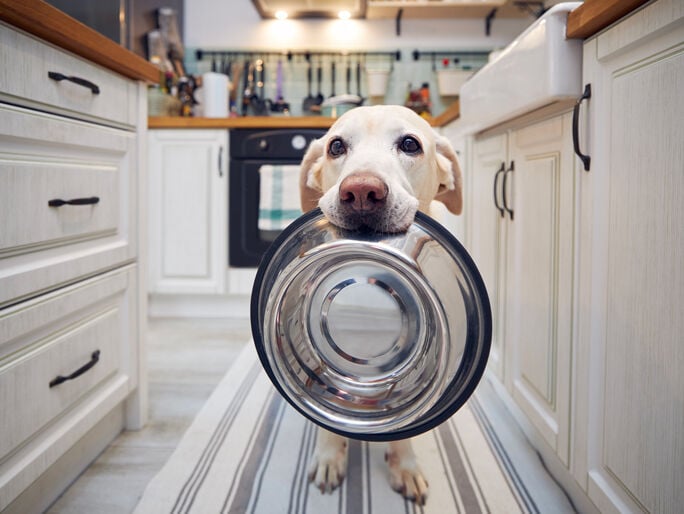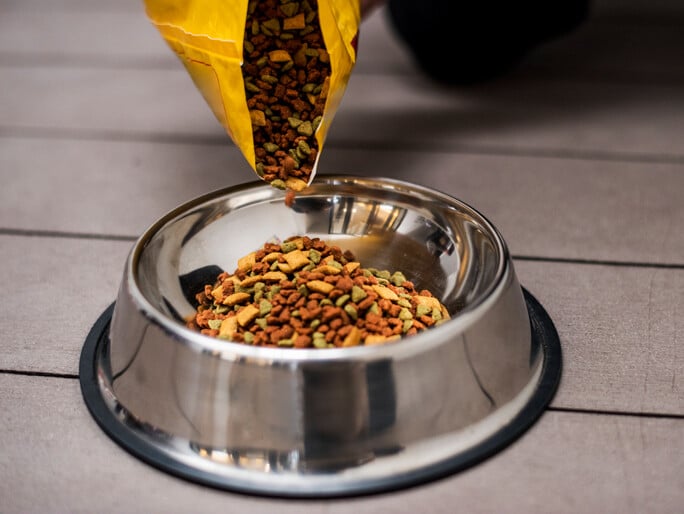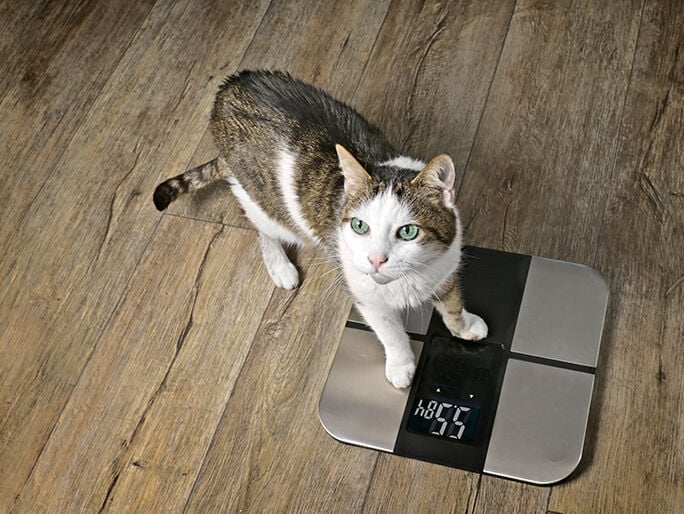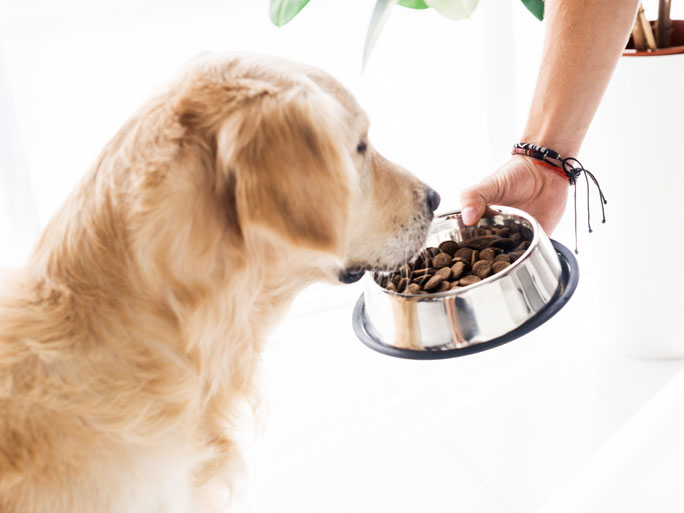Banfield pet food labeling guide
Get to know the ingredients for quality dog and cat food.
Here are quick tips on what matters and what doesn’t when making your choices in the pet food aisle.

Top 9 pet food ingredients
- Animal fat
- Animal protein
- Beet pulp
- Ground whole corn
- Ground whole wheat
- Meat
- Bone meal
- Chicken
- By-product meal
How to shop for a quality commercial pet food for dogs and cats
Get set to shop! What to know, ingredients to look for, and how to know if your pet’s food is meeting specific quality guidelines.

Look for AAFCO and FDA logos on commercial pet food packaging
Both the AAFCO and the FDA are regulatory agencies that allow commercial pet foods to use their logos if they meet certain standards. By choosing a dog or cat food with AAFCO or FDA logos, you can feel secure that the food is safe for that species to eat, was produced under sanitary conditions, contains no harmful substances, and is truthfully labeled.The Association of American Feed Control Officials (AAFCO): This organization regulates the animal (pet) food industry. They set the standards for which ingredients are allowed, what foods can be marketed to each species, and whether the foods are good for certain life stages.
United States Food and Drug Administration (FDA): The FDA regulates the actual manufacturing of food, including dog food, cat food, and pet snacks.
Know the AAFCO rules for ingredients in product names
Commercial pet food manufacturers have to follow AAFCO rules on naming and descriptions on their packaging. This means that a simple word — like “with”— can denote a big difference in what’s actually in your pet’s food.
For example, while two bags may both declare LAMB in large letters, the one that says lamb for dogs includes at least 95% lamb, while the one that says dog food with lamb includes at least 3%.
This usage doesn’t automatically mean that the 95% lamb version is always “better” or healthier for your pet (pets need more than just protein in a quality diet)!
Instead, these tips can help you get a better sense of what you’re paying for and avoid surprises when you read the list of ingredients.
A guide to pet food product names
An ingredient that’s listed with partner words like “dinner,” “platter,” or “entrée”
Picking a “lamb entrée for dogs” or a “salmon dinner for cats” means that the food has more than 25% of that ingredient for dry food, or 10% of that ingredient (after adding water) for wet food.
If more than one ingredient is listed, as in “lamb and rice entrée for dogs,” then there must be more of the first ingredient than of the second, and together they need to make up at least 25% of each serving.
Here are a few more common terms:
“Flavor”
Terms like “lamb flavor” or “salmon flavor” mean that the ingredient was used and can be detected by specific tests, but there’s no percentage claim. The name of the protein and the word “flavor” have to be treated in the same font, size, and color to help guide consumers.
“Stew,” “in sauce,” or “in gravy”
Pet foods using these or similar terms have extra water added for texture and fluidity.
There are special rules for using terms like natural, organic, and holistic
Many pet foods are described as natural, organic, holistic, or premium. Some terms come with an official industry definition. Others, not so much.
Natural foods
For an official stamp of approval on the term “natural,” look for the AAFCO logo.
The AAFCO requires that a natural feed or ingredient be:
- Derived solely from plant, animal, or mined sources
- In an unprocessed state
- Processed without chemicals or synthetics
- Free of additives or processing aids
Organic foods
The USDA and AAFCO are still developing their criteria for what it means for pet foods to be organic. Currently, to gain the AAFCO “organic” label, a food must be:
- Produced through approved methods that integrate cultural, biological and mechanical practices that foster cycling of resources, promote ecological balance, and conserve biodiversity
- Produced without synthetic fertilizers, sewage sludge, irradiation, and/or genetic engineering
Holistic, premium, and gourmet foods
There are currently no agencies regulating the meaning of the words premium or gourmet. Per the FDA, labeling a food with a fancier name does not necessarily mean it contains ingredients that are of quality.
Holistic is also not a regulated term. This is probably because the term means something that affects the entire body — in other words, just about everything your pet eats.
Even the water your pet drinks is 100% holistic!
Check out the table of ingredients, AKA the “ingredient deck”
When reading the table of ingredients, look for a digestible protein like meat, grain, soy, or pea at the top of the list. However, quality pet foods provide more than just protein. They should also provide critical carbohydrates for energy, vitamins and minerals for metabolism, and many other key nutrients.

- Animal fat: Animal fat promotes energy as well as healthy skins and coats.
- Animal protein: Often from red meat, chicken, or fish, animal protein is essential for healthy muscles and skin.
- Beet pulp: Beet pulps is a soluble fiber source that’s good for healthy skins and shiny coats.
- Brewer’s rice: An energy source that aids digestion, Brewer’s rice provides carbohydrates and fiber.
- Corn gluten meal: The concentrated essential amino acids and antioxidants in corn gluten meal builds, maintains, and repairs tissue, and helps the immune system.
- Ground whole corn: A great source of energy, corn contains essential amino acids, linoleic acid, fiber, and carbohydrates, all good for building lean muscles.
- Ground whole wheat: Full of carbohydrates, ground whole wheat is a great source of energy and fiber.
- Meat and bone meal: Full of concentrated essential amino acids as well as calcium and phosphorus, meat and bone meal help to maintain lean muscles as well as strong teeth and bones.
- Meat or chicken by-product meal: This kind of meal supports lean muscle, the immune system, and bone and joint health with concentrated essential amino acids and glucosamine.
- Vegetable oil: A good source of linoleic acid, vegetable oil helps healthy skins and coats.
- Wheat gluten: Wheat gluten is a digestible source of amino acids to support cell and tissue functions and help maintain muscle mass.
Get familiar with crude protein, crude fat, and the guaranteed analysis
After checking the ingredients, take a look at the guaranteed analysis. This chart lists a commercial food’s levels of crude protein, crude fat, crude fiber, and moisture. (“Crude” isn’t a quality term in this context: it refers to a specific kind of nutrient test.)
This analysis gives you a good idea how much good stuff is in each serving, versus bulking ingredients or water. This is also where you can see if “low-fat” food is actually low-fat, as well as what additional vitamins or minerals have been added.
Why does this analysis matter? It’s really about the difference between dry food and wet food. If you compare two equal servings of dry and wet, you’ll probably find that crude protein and nutrient levels are lower in the canned product. That isn’t necessarily bad! It’s just that all of the hydrating moisture that makes canned food delicious takes up space.
Canned food contains 75-78% water, whereas dry food contains only 10-12%. This water difference mostly affects how much of a given food your pet needs to eat to get the same amount of nutrition.
Dry food is more efficient at delivering nutrition in a smaller volume (you can feed your pet less dry food than wet food for the same nutrients) — but that fact in itself doesn’t automatically make it “better” for your pet.
Many pets prefer wet food or need the moisture it provides. So long as your pet is getting the nutrients they need, serving your pet quality wet or dry food is entirely up to you.
Get help decoding serving size recommendations on pet food
The “serving size” section on the label should specify how many cups — or cans or packets — are appropriate to serve pets of a certain weight each day. However, each pet is different. Your pet’s breed, age, health status, activity level, and other factors can influence how much food they actually need.
If you have any questions or concerns about your pet’s weight or nutrition needs — including obesity, weight gain, weight loss, recommended brands or specific diets, or calorie needs for exercise — it’s always good to check total daily calories and serving sizes with your veterinary team.
Mentioned in this article

All about quality pet food
Follow these mealtime guidelines for your furball.

Pet food nutrient guide
Find out what’s really in your dog or cat’s bowl.

Manage your pet’s weight
Info on calories, exercise, treats, and more.

Need advice on flea control? Ping Pet Chat™!
Whether it's 3 a.m. or 3 p.m., connect with a real veterinary professional for immediate petcare advice. It's included in all Optimum Wellness Plans®!
Log in to start chattingHow Banfield can help with dog and cat diet and nutrition
What your pet eats can make a big difference to their health! Our vets can perform physical exams, run tests, and help you manage your pet’s food-related issues, including obesity, diabetes, and food allergies.

Get help managing pet food allergies. Do you think your pet’s immune system is reacting to certain ingredients in their food? We can help identify pet food allergies and work with you on management diets.
Does your pet have diabetes? Let’s work together! This includes everything from recommendations on what to feed your pet, how to manage their food and injection schedule, providing appropriate prescriptions, and showing you how to safely perform insulin injections for the pet you love.
We can help your pet reach a healthy weight. We've got advice on diet and exercise for both overweight and underweight pets. Does your pet have a mobility issue that makes it hard for them to exercise? We can help there, too.
 Mites and mange
Mites and mange Podcast - Not Just Fluff
Podcast - Not Just Fluff



